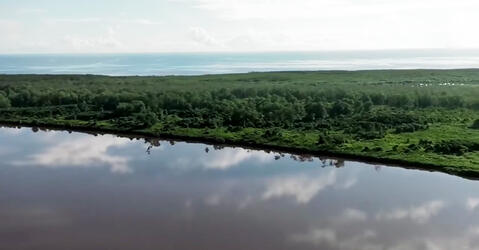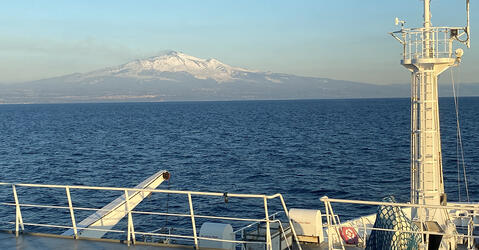Glacial Sounds
Here, in the depths of the earth, Science may soon shed its light on geological phenomena that still remain misunderstood.
The visitors using this network of underground tunnels are on a scientific mission 200 meters below the surface of the Argentiere Glacier, in the heart of the French Alps.
The hydroelectric company managing these tunnels has exceptionally given access to this team of researchers and engineers studying the glacier’s movements. Today, they are being guided Luc Moreau, a glaciologist, and protector of a little known scientific treasure.
The Argentiere Glacier is the only glacier in the world equipped with an ingenious device called a cavitometer, which has allowed continuous recording of the glacier’s movements for the past 30 years.
Luc Moreau – Glaciologist
It’s a bicycle wheel placed at the end of an arm, with a weight on the other end that presses the wheel against the glacier. It was my teacher Robert Vivian who had this idea in 1972, and I came along in 1986 so it’s been over thirty years that we’ve measured glacial movements with this instrument. It records the positions of both the arm and the wheel, as the height of the glacial ceiling can also vary. Everything is sent to a data station we have in the lab, measuring the glacier’s movement all day every day all year long.
This installation has produced a trove of valuable data on glacial dynamics over the decades. The movement of the ice has slowed dramatically due to its reduction in volume and weight. But in order to gather more precise data on this icy giant’s behavior, the team led by Philippe Roux will attempt to listen to the inner workings of the glacier from the depths of its base to the heights of its surface. The team will install a dozen seismic sensors within these tunnels to capture the glacial vibrations over the course of a month.
Philippe Roux – Physicist
Glaciers appear to be fixed objects, but they’re actually quite dynamic. They’re constantly moving, faster in spring as the ice melts and then they down again in the winter as the runoff is frozen and trapped. Our sensors will be recording what happens. We’ll measure crevasses that open and close, runoff provoked by thaw, and even the friction caused by the motion of the glacier. That friction of the ice rubbing against the bedrock creates a noise that can help us understand the speed of the glacier and the way it moves.
The scientists won’t rely solely on seismic sensors under the glacier alone, but will need instruments deployed on the surface as well. This ambitious scientific program is called RESOLVE. Its goal: to create the world’s most densely instrumented glacier, and collect scientific data over the span of a whole month.
This giant glacier covers 19 square km, and has lost a meter of thickness every year since the 1980s. The effects of climate change could accelerate this trend in the near future. Sensitive to air temperature and precipitation, glaciers are excellent climate indicators. And the RESOLVE project could reveal their inner mechanics.
The team of fifteen scientists from different scientific disciplines has come together. They’ll work for two days at an altitude of over 2,500m. This environment requires alpine training to guarantee the team’s safety.
Some team members are setting foot on a glacier for the first time.
After climbing, for two hours with skis, the RESOLVE team arrives at the zone of study. Among the instruments to be installed along the surface of the glacier, the seismic recorders in particular are what interest Coralie Aubert. She will coordinate their deployment within a network of 100 recorders. Each node of the network must be installed, activated, and verified – within a 48 hour window.
Here’s the map with the positions of all the nodes and on the other side you’ll find a table that lists them all out.
Coralie Aubert – Instrumentation Engineer
So the seismometer nodes are autonomous and comprised of three components, a battery pack, integrated digitizer, and three seismic recorders. We’ll set them out in a grid with 50m between each device. They’re going to record the vibrations for a month.
Installed with precise GPS coordinates, these recorders must also be calibrated. To do so, the scientists have brought an acoustic anvil which can emit three different types of vibration. One of the team members will strike it three times at precise intervals. If the recorders work as expected, the scientists will be able to find evidence of the sounds within the deluge of data. These signals can then be used to sync the data up in time. But seismology isn’t the only scientific discipline invited to the glacier.
Other team members are deploying a radar that will allow the mapping of the base of the glacier in 3D.
To supplement the passive recording of the glacier’s sounds, the scientists are also going to create their own icequakes - using this special anvil that can emit three different kinds of vibrations.
One of the team members will strike it three times at precise intervals. If the recorders work as expected, the scientists will be able to pinpoint the strikes within the data. Just like the other noises produced in the ice, these signals can then be used to map the interior of the glacier.
But seismology isn’t the only scientific discipline invited to the glacier.
Other team members are deploying a radar that will allow the mapping of the base of the glacier in 3D.
Ildut Pondaven – Engineer
The idea is to send electromagnetic waves through the ground at a particular frequency. We’ll walk with this generator, which is pretty small really, and will sweep the terrain where we’ve planted the nodes. There’s an emitting antenna in front and a receiving antenna behind. So the idea is that the waves are emitted down and reflected off the varying underlying faces of bedrock, which is what we’re most interested in mapping.
Thanks to these seismic recorders, radar imagery, and even water pressure sensors deployed 175m deep, this team will be able to collect a dataset never seen before. The information produced will be made freely available to the international scientific community and help understand the many mysteries of these icy giants.





